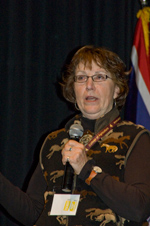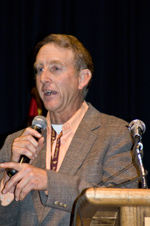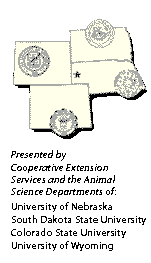Integrating Information Into Selection
Two cattle producers share their experiences with genetic selection.
by Kindra Gordon for Angus Productions Inc.
CASPER, Wyo. (Dec. 1, 2009) — Connee Quinn of Quinn Cow Co. near Pine Ridge, S.D., and Loren Berger of Berger’s Herdmasters near North Platte, Neb., shared their stories of improving the cattle selection processes on their respective ranches during the 21st Range Beef Cow Symposium in Casper, Wyo. Both Quinn and Berger utilize hybrid bulls and emphasized heterosis has been important to their operations.
 "Obtaining information like carcass data is easy, but interpreting the data is less easy," said South Dakota cattlewoman Connee Quinn. "You've really got to drill down and use that data to make decisions."Quinn explained that she and her husband, Rueben, have evolved from a two-way rotational back cross using registered Angus and Simmental bulls to now using AI on their heifers, and half-blood Angus-Simmental bulls on the majority of their cows. She explained that they keep their own replacement heifers, which are artificially inseminated (AI’ed) to Angus bulls, and retain calves and yearlings to finish in a commercial feedyard.
"Obtaining information like carcass data is easy, but interpreting the data is less easy," said South Dakota cattlewoman Connee Quinn. "You've really got to drill down and use that data to make decisions."Quinn explained that she and her husband, Rueben, have evolved from a two-way rotational back cross using registered Angus and Simmental bulls to now using AI on their heifers, and half-blood Angus-Simmental bulls on the majority of their cows. She explained that they keep their own replacement heifers, which are artificially inseminated (AI’ed) to Angus bulls, and retain calves and yearlings to finish in a commercial feedyard.
Quinn said they made the switch to simplify their life while still keeping the heterosis. AI was added to their heifers in an effort to improve reproductive efficiency under their environmental conditions, while also offering the ability to select for the traits needed for feedlot efficiency. Today, they are even developing some of their own bulls.
Quinn emphasized to beef producers the importance of using data such as ranch records, observations, and comparisons of calves to operate with. “Obtaining information like carcass data is easy, but interpreting the data is less easy,” she said. “You’ve really got to drill down and use that data to make decisions.”
Quinn credited Extension specialists from across the region with advising her and offering ideas throughout the years. She concluded saying, “At our ranch, we are striving to do the best we can, with what we have, continually learning, building relationships, anticipating change and keeping the parts glued together with commitment and passion for the choices we make.”
 Nebraska cattleman Loren Berger says the driving force behind his selection choices is to help his customers be profitable.Loren Berger explained that he operates a composite seedstock operation producing hybrid bulls consisting of Red Angus X Simmental and Angus X Simmental. Some high-percentage Red and Black Angus bulls are used on heifers.
Nebraska cattleman Loren Berger says the driving force behind his selection choices is to help his customers be profitable.Loren Berger explained that he operates a composite seedstock operation producing hybrid bulls consisting of Red Angus X Simmental and Angus X Simmental. Some high-percentage Red and Black Angus bulls are used on heifers.
His admiration for heterosis goes back to 1971 when he AI’ed a group of Hereford heifers to a Simmental sire. The result, he said, was some of the most productive cows he’d ever seen.
Berger, who hosts an annual bull production sale, said the driving force behind his selection choices is to help his customers be profitable. Maternal traits of fertility, mothering ability and longevity are most important. His second emphasis is on cost-of-production traits, which he lists as frame size, milk, growth rate and feed efficiency. Product traits related to carcass end product and calving ease are also considered.
“I believe the best thing I can do for my customers is to give them a simple, easy-to-manage method to sustain heterosis in the cow herd and take advantage of breed complementarity,” Berger concluded. “In my view, hybrid bulls are the simple answer to this complex dilemma.”
Editor’s Note: API's coverage of the event is made available for distribution to all media via an agreement with the Range Beef Cow Symposium Committee and API. Headquartered in Saint Joseph, Mo., API publishes the Angus Journal, the Angus Beef Bulletin, the Angus Beef Bulletin EXTRA, and the Angus e-List, as well as providing online coverage of events and topics pertinent to cattlemen through the API Virtual Library. For questions about this site, or to notifiy us of broken links, click here.
